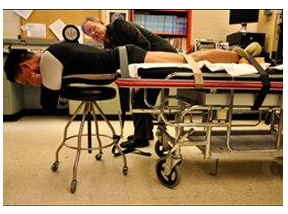INTRODUCTION
Since the advent of human spaceflight in the mid-20th century, the science of space physiology has strived to explore answers into the deleterious effects of microgravity especially to the musculoskeletal system among all the other physiologic systems altered. Prolonged exposure to microgravity greatly reduces the inherent biomechanical forces needed for health and homeostasis of the musculoskeletal system adapted to a 1G environment. Atrophy, degeneration, and deconditioning of supportive skeletal muscles have been largely pointed out as the cause of weakness experienced by astronauts upon return to a 1G environment so various exercise countermeasures have been employed during prolonged space missions. This research explores the role of par spinal muscles with measurements of back strength pre- and post-flight in relation to muscle atrophy and back pain reported by astronauts before and after six month missions aboard the International Space Station (ISS) and proposed spine exercise countermeasures with regard to the most appropriate exercise components most appropriate to address specific spine muscle isoforms involved with atrophy, deconditioning, and reduced neuromuscular reflexes. There had also been documented incidents of herniated nucleus pulposus (HNP) after spaceflight and this study will attempt to correlate incidences to back strength as well as back pain reported and paraspinal muscle atrophy.1,2) Our project will help define the most physiologically appropriate type of exercise components to deter the maladaptive effects from prolonged spaceflight and FCSA of the par spinal muscles, reduce back pain and incidences of HNPs, prevent dysfunction or injuries and to improve astronaut performance in space and after return to a gravitational field of a planet, moon, or asteroid.
METHODS
Institutional research board approval was obtained from the National Aeronautics and Space Administration (NASA) and the University of California, San Diego. Twelve astronauts consented to participate as test subjects to our study from 2012-2018. All astronauts were crewmembers for six-month missions (with one extending one year) onboard the International Space Station. Crewmembers were subjected to a back strength isometric endurance assessment using the Biering-Sorensen Test pre- and post-flight.3 Nine data sets were collected. The Biering-Sorensen Test was utilized as the back strength assessment tool to quantify by hold time, the ability of the paraspinal extensor muscle group to hold the vertebral column in a static and horizontal position while the pelvis is stabilized (Fig.).
RESULTS
Complete Biering-Sorensen Test comparison results pre- and post-flight were collected from nine out of the twelve crewmembers. The other three were excluded due to precautions on suspicion of actual or potential back pathologies. The mean hold time for the Biering-Sorensen Test decrement for the nine data set to date approached 30 sec. Preliminary results indicate a pre-flight to post-flight t-test score of 0.000954. There was a reduction of the isometric hold time for the spine extensors indicating significant weakness post-flight.
DISCUSSION
The results of this study showed spine muscle weakness using the Biering-Sorensen Test occurs concurrently with reported atrophy of the multifidus, erector spinae, quadratus lumborum and psoas, reduced cross-sectional area (CSA) and functional cross-sectional area (FCSA) with MRI measurements.4,5) We propose an exercise prescription using high repetition dosage which may be more functional based on the type of muscle fiber isoform predominance in the spine. Physiologically efficient mechanotransduction to the spine requires cyclical stress to spinal structures.6) Human skeletal muscle is subdivided based on two isoforms (a) Myosin Heavy Chain muscle isoform Type 1 (MHC I) synonymous to red muscles/slow-twitch fibres, and (b) Myosin Heavy Chain muscle isoform Type II (MHC IIx/d aka MHC IIb) or white muscles/fast-twitch fibres.7 MHC I are oxidative and fiber development results from low to moderate loads at higher repetitions (aerobic metabolism) whereas MHC II are glycolytic and responds by higher loads at lower repetitions (anaerobic metabolism).8,9 Postural functioning MHC-I muscle fibres of the lower extremities atrophy in greater proportion than MHC-II during spaceflight10 but the proportion of MHC-I to MHC-II atrophy in the spine is not defined. It is most likely that atrophy of the spinal postural muscles becomes a primary musculoskeletal response to unloading with deconditioning in-flight. To match the exercise intensity suited to the predominant muscle isoform in the spine, exercise dosage with lower load resistance and higher repetition increments may be the most appropriate mechanical stress in the exercise protocol development.1 If exercise intensity to the back muscles becomes too high, it may cause injury. As such, even though the incidence of in-flight musculoskeletal injuries with exercise is low, there is a relatively high number of minor back injuries incurred while using current ISS exercise equipment. In microgravity the resistance of the pulley may include a pneumatic mechanism or a modified flywheel that can produce a constant load. A specially-designed adjustable bench with straps to stabilize the pelvis and to pre-position the astronaut prior to commencement of the designated exercises is possible. In microgravity conditions, the objective of these exercises is to provide biomechanical compression to the spine via optimized muscle contraction using functional spine movements in tri-planar directions [flexion or extension combined with simultaneous side-bending and rotation] as opposed to traditional uni-planar spine movement exercises (strict flexion, extension, or side-bending). Functional spine exercises will likely cause efficient mechanotransduction with cyclical stress to spinal structures.6
CONCLUSIONS
Long duration spaceflight despite exercise protocols in the ISS, result in paraspinal muscle atrophy and strength decrements. Current exercise protocols using onboard workout equipment (Advanced Resistive Exercise Device (ARED), Treadmill Vibration Isolation System (TVIS) Cycle Ergometer with Vibration Isolation System (CEVIS) and currently used by astronauts do not have a spine specific regimen and not sufficient to maintain musculoskeletal conditioning of the spine. Our study shows a need for new exercise equipment and new exercise protocols dedicated to optimal application of physiological mechanotransduction to the paraspinal muscles with resistance and repetitions specific to conditioning the muscle isoform group Myosin Heavy Chain muscle isoform Type 1 (MHC I) synonymous to red muscles/slow-twitch fibres, that atrophy the most.















